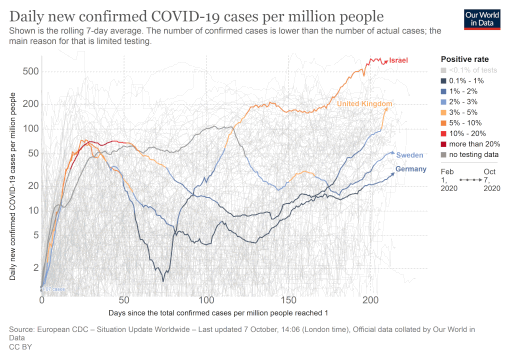
(click to enlarge)
Zum Seitenende Übersicht Artikel Home & Impressum
First the link to this week’s complete list as HTML and as PDF.
***
Heudorf & Gottschalk claim that Covid infections have become much milder since the onset of the epidemic. This may well be so, medicine has learnt a lot about treating the disease, but it could also be an artifact. In the first phase most mild infections were probably overlooked. From their figure 10 all infections since July could well be false positives. This may have been so, although I consider it improbable. From September onward however the rate of positive tests has risen far above the plausible false positive rate and the current trend, if perhaps not the absolute figures, must certainly be genuine.
***
Nelde et al. presupposes an understanding of the immune system I definitely lack. I include them here only because I found them misquoted and misinterpreted by political activists. I understand just about enough to see Nelde et al. do not claim, 81 % of the general population have a preexisting immunity against SARS-CoV2. This puts me in a quandary. My ongoing mantra is “ignore the yellow press, read the primary sources yourself”
. But what about all those lacking the prerequisites for that approach? Of course what there ought be is factually correct yet accessible reporting about current science. This is the one thing we very clearly don’t have. So what’s to do? For the time being I’ll stick to my former advice while being a bit more alert to its pitfalls.
***
Granted, Sweden is different from other countries, but not as different as Vogel tries to make out. Looking at a comparative diagram Sweden’s most striking quality is its level and even course. Compare that to Israel’s and to a lesser extent Germany’s striking and extremely expensive drops followed by a continuous and so far unstoppable resurge.
As of now Sweden’s case is far from closed and may yet prove a success story. Yes, there were mistakes made in the beginning as the first wave in care homes shows, but so they were everywhere. We are only now beginning to learn what seems to work and what doesn’t and this is not helped by everybody doing everything at once and at the same time.
***
Shaus et al. list many caveats for their work themselves. Looking at their figure 3 I find it hard to decide, whether the differences seen are due to different writers or just different pens and surfaces. Separate block letters in place of joined-up writing are notoriously difficult for modern graphologists. Their result is possible but it’s probably best to treat it as an upper limit not a proven number.